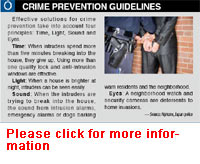A&S examines protection against crime, identifying what could happen and available security solutions.
A&S examines protection against crime, identifying what could happen and available security solutions.
Crime has declined globally, but no place is completely safe. In 2006, about 207,000 homicides took place worldwide, according to the Tenth United Nations Survey on Crime Trends and Operations of Criminal Justice Systems. India reported 32,481 homicides, topping the list with nearly double the count of the United States.
As the credit crunch slows the global economy, some experts predict crime rates to grow. "Often there is a trend to see the sale of personal safety devices increase when there's a downturn in the economy," said Steve Tuttle, VP of Communications, TASER International. "The logic behind that is perhaps people are seeing more crime or simply basic primal needs become more of a focus for people."
Protection against crime factors significantly into security. Access control prevents intruders, alarms sound alerts for disturbances and surveillance records video to identify perpetrators. If someone becomes the victim of crime, they can turn to emergency response solutions, such as intercoms or personal defense devices. Security becomes a crucial tool in crime situations.
Some individuals are more vulnerable when confronted with crime. Senior citizens are less likely to experience crime, but when they do, there is a 92 percent chance it will occur in or near their homes, according to the U.S. Department of Justice. For the elderly, home invasion is a serious risk to their property and safety.
 However, crime generally does not discriminate. "It targets any opportunity," Tuttle said. "You'd be surprised by crimes against men. It could be the young, elderly, male, female — it could be anyone."
However, crime generally does not discriminate. "It targets any opportunity," Tuttle said. "You'd be surprised by crimes against men. It could be the young, elderly, male, female — it could be anyone."
The cost of crime can be high. For vandalism alone, the U.S. Department of Justice estimated schools, homeowners and businesses pay more than US$15 billion a year. As crime has the potential to harm individuals and property, security offers protection.
Fighting Crime
Sharp images and real-time communication can help stop crime. "Quality network cameras and IP communication are trends for crime prevention," said Koji Asano, GM of International Sales, Aiphone. "IP communication is useful for a long distances, such as in parking lots between a help point and security control center."
While cameras alone cannot fight crime, their footage provides effective testimony. A study of Scotland Yard murder investigations found that 65 cases were solved with video surveillance, out of 90 cases for a one-year period. Video records were used in 86 of the 90 cases, as Britain has an estimated 4.2 million cameras — one of the highest camera counts in the world. Identifying killers makes cameras vital for solving crimes.
For general crimes, the placement of a camera reduced property crime by 24 percent in a 100-foot radius, according to a 2008 study of San Francisco public  cameras conducted by the Center for Information Technology Research in the Interest of Society (CITRIS), part of the University of California, Berkeley. Property crimes included homicide, rape, robbery and arson, which were monitored as part of the city's Community Safety Camera program.
cameras conducted by the Center for Information Technology Research in the Interest of Society (CITRIS), part of the University of California, Berkeley. Property crimes included homicide, rape, robbery and arson, which were monitored as part of the city's Community Safety Camera program.
The study found cameras did not affect unpremeditated crimes. "We find no evidence of an impact of the Community Safety Cameras on violent crime," the CITRIS report said. As cameras make offenders aware of possible arrest, they will be less motivated to commit a crime. However, a perpetrator of an unplanned crime may not account for cameras. This makes surveillance a deterrent for planned property crimes, but not violent crime.
Intercoms
For dense areas like cities, communications aid crime response.
"We are an intercom system manufacturer, so we concentrate our crime prevention solutions on home invasions," Asano said. "According to burglar interviews in Japan, nearly 50 percent of the home intruders used the audio door station to confirm if the resident was in or out."
Adding video to door phones can help nab suspects. "When the video intercom system was equipped, the risk for the intruder's face to be shown was higher," Asano said. "The video intercom system is a deterrent to crime."
With access control in place, an intercom plays an important role for preventing home intrusion. This is key for apartment buildings, where multiple tenants reside. An effective intercom, particular video intercoms, can protect residents from crime.
Personal Safety Devices
Should a person be confronted by an attacker, having something to defend oneself offers added assurance. Weapons such as guns or knives can inflict damage on an attacker, but could hurt innocent bystanders. To overcome these weaknesses, some personal defense devices are designed for temporary incapacitation without injuring the attacker, buying victims time to escape. Solutions aimed at stopping attackers include chemical sprays and stun guns.
One stun gun solution is the TASER device, which deploys two probes delivering electrical impulses, Tuttle said. The impulses will override the body's nervous system, causing an attacker to lose muscular control and coordination, but not consciousness.

The consumer version of the TASER device administers electrical impulses for 30 seconds, long enough for someone to run for help while keeping the assailant down. "In numerous human tests, we have not found a dangerous effect, such as damage to the heart or breathing," Tuttle said.
TASER's solution includes a safety cover for the trigger button, to stop accidental deployments. To prevent abuse, purchasing a TASER device requires a background check and activation process to unlock it after purchase, ensuring the person's identity. Should a TASER be deployed, it will also disperse anti-felon identification tags, or serialized confetti, matching the device used to its registered owner.
This careful distribution makes the TASER unique, as chemical sprays do not require registration and bullets cannot be matched to specific gun owners. "We check your background, and provide checks and balances on forward behavior," Tuttle said. "TASER stands for a safer and more effective alternative, with unmatched accountability."
Applications
Using safety solutions is central for preventing crime, such as spontaneous attacks. "If someone comes up to you when you have a TASER device on your person, you can still fight back with it," Tuttle said. "This ranges from walking to a car to being mugged."
Safety devices can help ward off intruders. "The other useful area would be personal home invasion, if someone came into your house in the middle of the night," Tuttle said. "We've also had these used to prevent a lot of robberies."
Best in Class
In education, cameras are used in public areas to watch for vandalism and crime. A Bosch Security Systems video solution was installed at a U.K. secondary school after a vandalism incident. The cameras watch for study activity, check traffic and record visitor movements, according to a Bosch prepared statement.
For universities and higher education institutions, increased foot traffic make video footage important for crime investigations. At a Hungarian university, cameras and Intellio video analytics alert campus security to events, with IP making real-time response to crime possible.
Installed since September 2008, the cameras watch over the Hungarian campus. "The cameras protect against theft and burglaries on the university grounds, as well as reduce damages incurred during renovation works and various venues hosted at the university," Intellio said in a press release.
Finally, video footage can identify perpetrators of crimes, which were captured by Axis Communications' network cameras at an American university. The Axis video installation will be integrated with the local police system, so law enforcement can see the campus during emergencies and respond appropriately, according to an Axis prepared statement. The video installation has already reduced campus crime, making students feel safer.
Warding Off Crime
No single solution eliminates crime. However, a combination of technologies and effective law enforcement can help reduce it. From installing reliable equipment to being prepared for surprises, security safeguards people from becoming victims of crime.